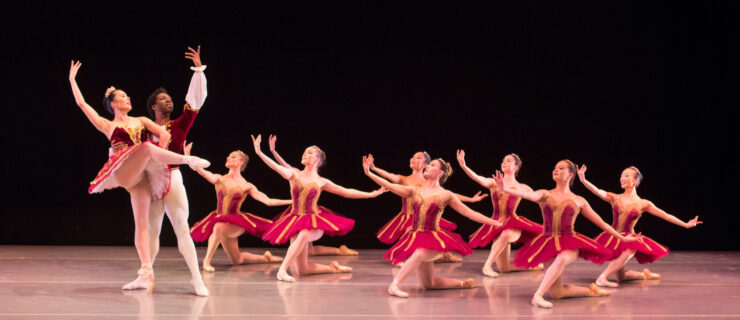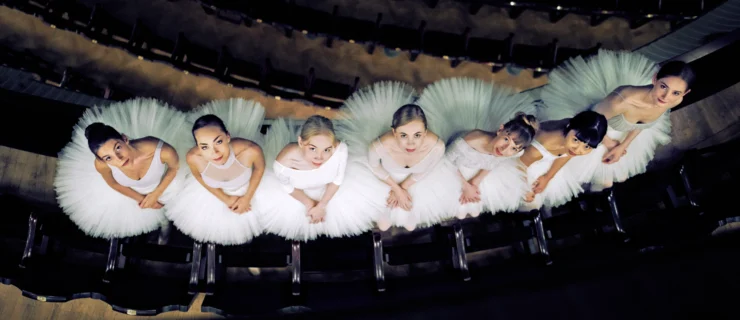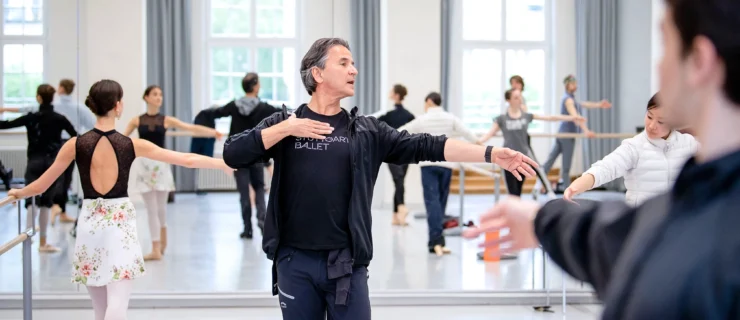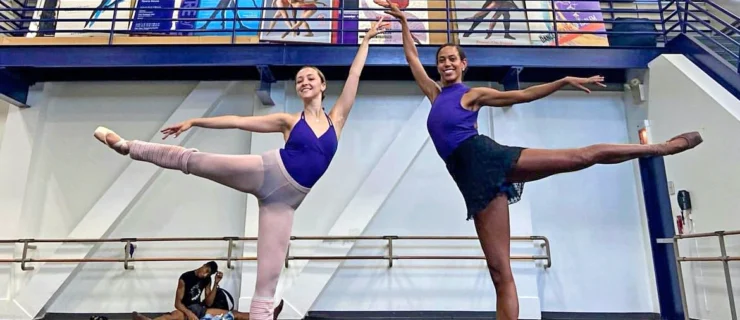The College Conundrum
Midway through his second semester of college, Chris Peddecord started to feel like something was wrong. Though he’d chosen a dance department with great faculty—which included one of his former teachers—he didn’t feel the training was strong enough to prepare him for a professional career.
“The rep we were performing wasn’t what I wanted to be dancing,” he says. He couldn’t take a daily technique class because they were scheduled at inconsistent times, and men’s and pas de deux classes were not offered often enough. He also wasn’t building the network he had hoped for. “If the university had been in a large city with closer relationships to professional dance companies, the other issues wouldn’t have been so bad,” he says. “But a huge part of being an aspiring professional dancer is making contacts with companies.”
Peddecord transferred to the University of Utah, where he’s currently a senior majoring in ballet. He found both the schedule and the contacts he felt were missing before: Not only does he dance daily from 9:45 am to 4 pm, he also performs professionally with Salt Lake City’s Repertory Dance Theatre and he won an outstanding choreography award at this year’s Youth America Grand Prix—both opportunities gained through his UU network.
While the level of ballet training available in college is higher than ever before, programs vary. Among the many choices you will need to make before you apply is to decide whether you want a liberal arts program, where you can explore other academic interests, or a conservatory program, where you’ll be dancing in the studio almost all day. Both paths can lead you to a professional career in ballet, but neither in itself ensures that you will get enough—and strong enough—ballet training. A lot will depend on what you make of what you are given.
No two programs are alike, so take the time to do the research to see which program best matches your goals.
What To Look For
One of the biggest indicators of a ballet program’s quality and philosophy is its faculty. It’s not just about how many ballet teachers are on staff: “Look at the affiliations the faculty have, their training and their teaching styles,” advises Elizabeth Ahearn, chair of the dance department at Goucher College. Teachers may specialize in a certain technique, like Balanchine or Vaganova, which might dovetail with your previous training—or push you out of your comfort zone. The faculty’s professional contacts can also help you when you’re ready to start your career.
Look at where the program’s alumni have ended up. Are the majority dancing professionally? What companies are they in? If a department produces mostly modern or Broadway dancers, it is probably not the right fit if your goal is to perform ballet.
As far as the curriculum goes, make sure that multiple technique levels are offered. Also look at class schedules: Is a daily technique class required? Find out whether the department offers other disciplines like modern or jazz—and whether you’re required to take them. Indiana University and the University of Utah, for instance, have separate departments for ballet and modern to allow students to hone in on their genre of choice. At other programs like the dance department at Goucher, dancers must be equally proficient in both ballet and modern. The upside is that this type of program could help you become more comfortable in contemporary movement.
Finally, find out about performance opportunities. How many productions does the department put on? Can all students (not just upperclassmen) dance in faculty and guest artist works? Which guest artists has the department hosted in recent years?
“At college, dancers learn from their teachers, of course, but they also develop their technique through the choreography they perform,” says Michael Vernon, chair of IU’s department of ballet (which brought in New York City Ballet’s ballet master Russell Kaiser as a guest teacher last year). Working with top-notch guest artists will help prepare you for life as a pro: “At IU, we do Balanchine through the Balanchine Trust. This coming season we’re going to do a Twyla Tharp ballet,” Vernon says. “We get the same people who are staging for major companies.”
See For Yourself
There’s only one surefire way to know if a school is right: Visit the campus. “It’s a relationship that one can feel on instinct,” says Vernon. “You have to sense that this place is right for you.” But don’t let yourself get swept away by fancy dorm rooms and a lush, green quad—you need to keep a sharp eye out for the indicators that will tell you if the training will be of the caliber you need.
During your visit, take (or observe) a ballet class. Listen to the corrections the teachers give—and see how students respond. Are dancers focused and attentive throughout class? Are they dressed appropriately? Are pointe shoes required? You know what kind of training environment you need, and if you don’t see it during your brief visit, you’re not likely to be satisfied as a full-time student.
Attend a dance department performance. Tour the facilities and arrange a meeting with a faculty member to discuss your goals and how they might be met by that program. Be honest with your questions and concerns—this is your time to find out what you need to make the right choice. Try to spend a night on campus, and while you are there, speak with several current dance majors—especially those with a ballet focus—to get their take on what the program is really like. Throughout the process, go with your feelings: If you step into the studio and it feels like home, you’re probably on the right track.
Keep An Open Mind
No matter what type of program you choose—and even if you don’t find everything you were looking for—college is an opportunity to become a well-rounded, educated artist, armed with a network of friends, teachers and collaborators who can help you achieve your goals. Through the process, you might discover things about yourself you didn’t know. And if you watch a modern class that excites you, don’t disregard that program—it might become a new passion: “My world exploded when I got to college,” says Sarah Chien, who trained with BalletMet for a year before attending Barnard College in New York City. “I had been an intense dancer my whole life, and my standard was ballet, ballet, ballet. Now, I’ve studied so many other things. It’s revitalized my view of dance!”
5 Tips from New World School of the Arts College Assistance Program advisor Helen Witty
> Start visiting schools in 10th grade—you’ll have a head start when you’re ready to apply. Even if you haven’t yet decided that you want to go to college, going on campus will help you figure out if it’s right for you.
> Talk to your teachers about programs that might be a good fit for you. They know your strengths and weaknesses, and should be able to recommend places where you’ll thrive. But keep in mind that the end decision is yours.
> If you’re uncertain about college, you can defer admission for a year to spend time apprenticing or studying intensely. Note: When deferring college admission, make sure to present your plan to the school—and get it approved in writing.
> Always check online for the most up-to-date information on audition dates and application requirements.
> Look beyond the dance department: Do you want to live in a big city or on a traditional campus? Is the university outstanding as a whole? What opportunities do you have for a social life on and off campus? Your overall satisfaction with the school depends on these answers.
Make It Work
Even if you spent a year or two researching dance departments, it’s possible that the college you choose won’t turn out to be everything you’d hoped for. It’s heartbreaking to invest yourself in a dance program and then arrive to realize it’s not a good fit. What are your options to make the most out of the program? Take control: It’s your professional career on the line.
Give It Some Time
It’s natural to need time to adjust, so give your program at least one semester. Reflect on why you chose the school—the illustrious alumni? particular staff members? the professional connections?—and don’t just dwell on what is different from what you’re used to. Even if you feel like you aren’t getting strong enough ballet training, don’t let that frustration influence all that you can learn from other classes.
Actively Seek Advice
If you’re devoting four years to higher education, you are not only entitled to a great curriculum, but also to teachers and directors who can advise you. “Don’t be afraid to talk to your professors,” says David Allan, the director of Ballet Studies at the University of California at Irvine. Even if they don’t have all the answers, Allan notes, they can point you to the person who does. Your faculty is probably happy to help, but they have to know that there is a problem.
When Autumn Hill, a recent graduate of The Boston Conservatory, felt she wasn’t getting enough technique, pointe and partnering classes, she spoke with the director. “She listened, and added more classes to our schedule,” she says. “The best people to ask are the people in charge.”
Although the director may not immediately change the program’s schedule, he or she might allow you to take extra ballet classes for no credit or to put on your pointe shoes during technique class (which Hill also did). If you feel uncomfortable expressing your concerns to a teacher or director, talk to older students; chances are they have been in your shoes. They have already established relationships with faculty that you may be just getting to know—ask for an introduction or for advice on making that first contact.
Look Outside The Dance Department
Don’t settle for what you’re given. Many college students look to local studios for extra technique classes and stage experience. Performing in community Nutcrackers and spring showcases can be great additions to your resumé.
If you can’t find any opportunities that excite you, create one that does. Frustrated by a lack of performance opportunities, students at Columbia University created the Columbia Ballet Collaborative, a student-run organization promoting classical and contemporary ballet in the school community. Senior Michael Novak, CBC’s artistic associate, loves the Collaborative because it not only provides performance and choreographic opportunities, but also “healthy competition and a mentoring system for freshmen, as a lot of us have professional experience.”
Transfer
If you still find that your needs are not met, look into other schools. It never hurts to audition, and knowing what you don’t like will help you better identify what you do value in a program. “Don’t stay for the name, or to please parents or friends,” advises Hill. “Trust your best judgment.” It’s a tough decision, but your future is worth getting it right.
—Kina Poon
Kathryn Holmes is a dancer and writer in New York City.





